Burlington Coat Factory IPO Analysis
VerifiedAdded on 2019/09/20
|12
|1920
|231
Report
AI Summary
This report provides a comprehensive analysis of Burlington Coat Factory's Initial Public Offering (IPO) in 2013. It examines the company's background, its position within the off-price retail industry, and its financial performance leading up to and following the IPO. The report details the IPO process, including the number of shares sold, the share price, and the total capital raised. It also analyzes the post-IPO stock price trend, noting a significant increase. The report concludes that the IPO had a positive impact on the company's financial growth, contributing to increased revenue and shareholder profits. Financial data from SEC filings (10-K forms) are used to support the analysis, along with discussion of relevant factors such as the company's size, product range, and competitive advantages. The report also touches upon considerations for companies planning an IPO, such as assessing their readiness, choosing distribution methods, and understanding SEC requirements.
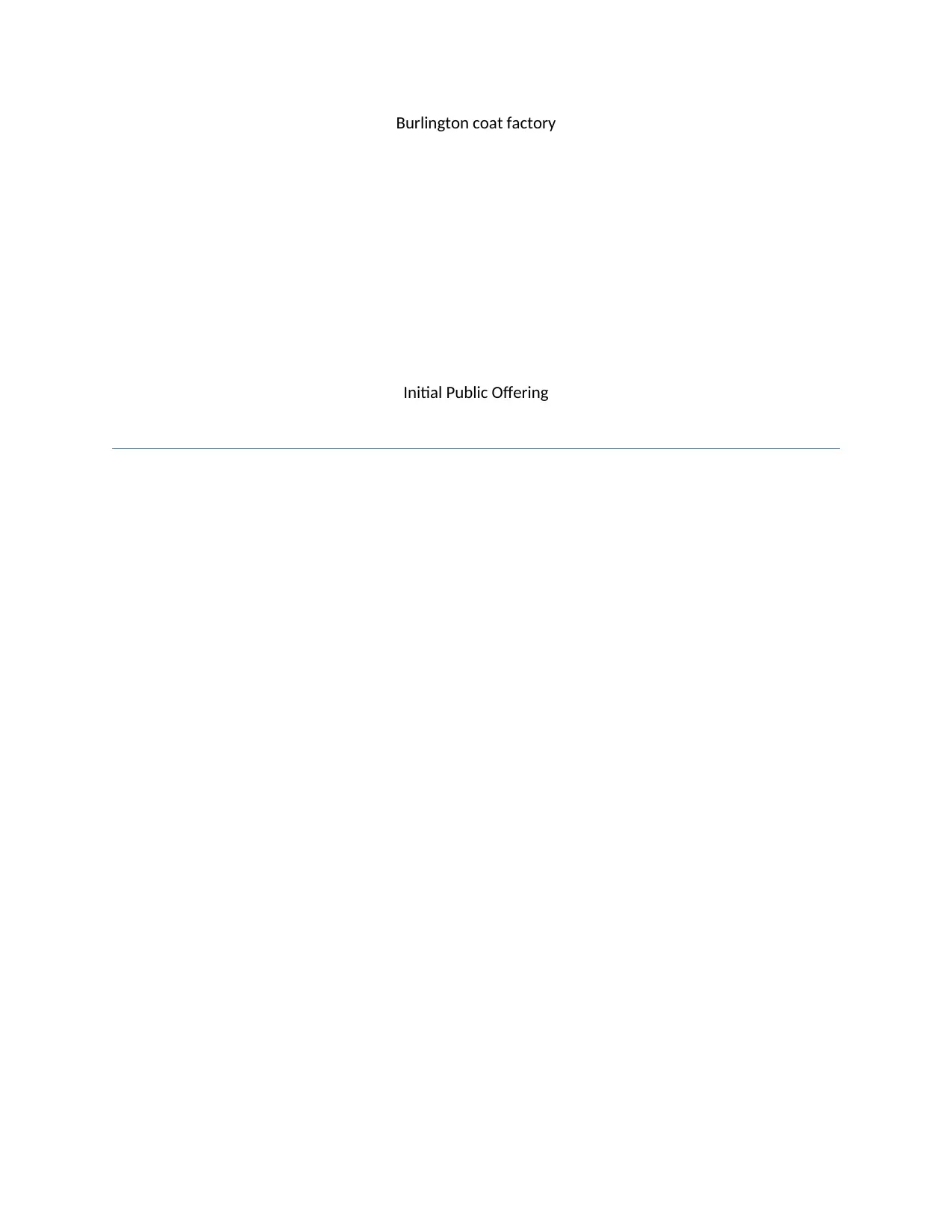
Burlington coat factory
Initial Public Offering
Initial Public Offering
Paraphrase This Document
Need a fresh take? Get an instant paraphrase of this document with our AI Paraphraser
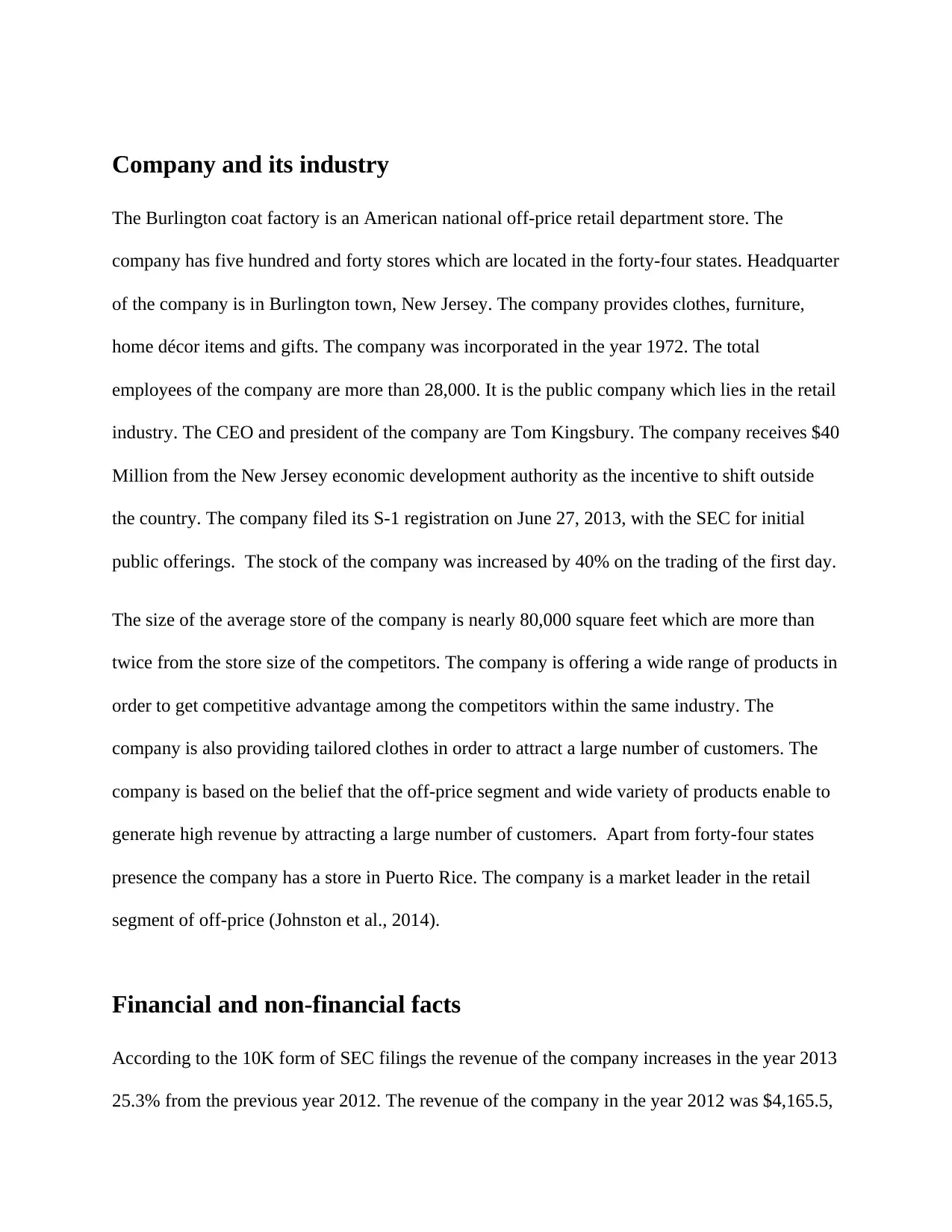
Company and its industry
The Burlington coat factory is an American national off-price retail department store. The
company has five hundred and forty stores which are located in the forty-four states. Headquarter
of the company is in Burlington town, New Jersey. The company provides clothes, furniture,
home décor items and gifts. The company was incorporated in the year 1972. The total
employees of the company are more than 28,000. It is the public company which lies in the retail
industry. The CEO and president of the company are Tom Kingsbury. The company receives $40
Million from the New Jersey economic development authority as the incentive to shift outside
the country. The company filed its S-1 registration on June 27, 2013, with the SEC for initial
public offerings. The stock of the company was increased by 40% on the trading of the first day.
The size of the average store of the company is nearly 80,000 square feet which are more than
twice from the store size of the competitors. The company is offering a wide range of products in
order to get competitive advantage among the competitors within the same industry. The
company is also providing tailored clothes in order to attract a large number of customers. The
company is based on the belief that the off-price segment and wide variety of products enable to
generate high revenue by attracting a large number of customers. Apart from forty-four states
presence the company has a store in Puerto Rice. The company is a market leader in the retail
segment of off-price (Johnston et al., 2014).
Financial and non-financial facts
According to the 10K form of SEC filings the revenue of the company increases in the year 2013
25.3% from the previous year 2012. The revenue of the company in the year 2012 was $4,165.5,
The Burlington coat factory is an American national off-price retail department store. The
company has five hundred and forty stores which are located in the forty-four states. Headquarter
of the company is in Burlington town, New Jersey. The company provides clothes, furniture,
home décor items and gifts. The company was incorporated in the year 1972. The total
employees of the company are more than 28,000. It is the public company which lies in the retail
industry. The CEO and president of the company are Tom Kingsbury. The company receives $40
Million from the New Jersey economic development authority as the incentive to shift outside
the country. The company filed its S-1 registration on June 27, 2013, with the SEC for initial
public offerings. The stock of the company was increased by 40% on the trading of the first day.
The size of the average store of the company is nearly 80,000 square feet which are more than
twice from the store size of the competitors. The company is offering a wide range of products in
order to get competitive advantage among the competitors within the same industry. The
company is also providing tailored clothes in order to attract a large number of customers. The
company is based on the belief that the off-price segment and wide variety of products enable to
generate high revenue by attracting a large number of customers. Apart from forty-four states
presence the company has a store in Puerto Rice. The company is a market leader in the retail
segment of off-price (Johnston et al., 2014).
Financial and non-financial facts
According to the 10K form of SEC filings the revenue of the company increases in the year 2013
25.3% from the previous year 2012. The revenue of the company in the year 2012 was $4,165.5,

Million. The net sales of the company are increased by $277.3 Million which is 7.2%. The net
sales of the company mainly increased from opening new stores and the revenue from the
previous stores was $197.0 Million (Year et al., 2014). The comparable sales of the stores were
increased by 1.2%. The gross profit to the net sales was increased by 32.8% from 38.7% in the
year 2012. The selling and administrative expense of the company increases from 31.5% to
31.9% in the year 2012. It includes the expense of opening a new store which is $67, Million.
The company had $6.3 Million net loss in the year 2011 whereas the net income in 2012 was
$25.3, Million. The following table shows the revenue and income rate of the company:
Particular 2008 2009 2010 2011 2012 2013
Revenue $3424 $3571.4 $2479.3 $3701 $3887.5 $4165.5
Net income -49% -191.6% 18.7% 31.0% -6.3% 25.3%
The revenue of the company increases in the year 2012, but the company has a net loss of 6.3%.
It shows that the company is struggling for business expansion. Moreover, the company is still
profitable. The company has opened its new store which shows that the company is expanding in
order to gain high profit in the long run.
Another financial fact of the company includes that the company has no long-term liability. The
total assets of the company in 2013 were $2741, 912 and total liability and stockholders' equity
of the company was $1741, 912. Since initial public offerings, the company has raised its debt,
so the company needs not to pay interest expense. The reduction in the interest rate helps to
increase the value of the company. The company has successfully implemented the strategic
sales of the company mainly increased from opening new stores and the revenue from the
previous stores was $197.0 Million (Year et al., 2014). The comparable sales of the stores were
increased by 1.2%. The gross profit to the net sales was increased by 32.8% from 38.7% in the
year 2012. The selling and administrative expense of the company increases from 31.5% to
31.9% in the year 2012. It includes the expense of opening a new store which is $67, Million.
The company had $6.3 Million net loss in the year 2011 whereas the net income in 2012 was
$25.3, Million. The following table shows the revenue and income rate of the company:
Particular 2008 2009 2010 2011 2012 2013
Revenue $3424 $3571.4 $2479.3 $3701 $3887.5 $4165.5
Net income -49% -191.6% 18.7% 31.0% -6.3% 25.3%
The revenue of the company increases in the year 2012, but the company has a net loss of 6.3%.
It shows that the company is struggling for business expansion. Moreover, the company is still
profitable. The company has opened its new store which shows that the company is expanding in
order to gain high profit in the long run.
Another financial fact of the company includes that the company has no long-term liability. The
total assets of the company in 2013 were $2741, 912 and total liability and stockholders' equity
of the company was $1741, 912. Since initial public offerings, the company has raised its debt,
so the company needs not to pay interest expense. The reduction in the interest rate helps to
increase the value of the company. The company has successfully implemented the strategic
⊘ This is a preview!⊘
Do you want full access?
Subscribe today to unlock all pages.

Trusted by 1+ million students worldwide
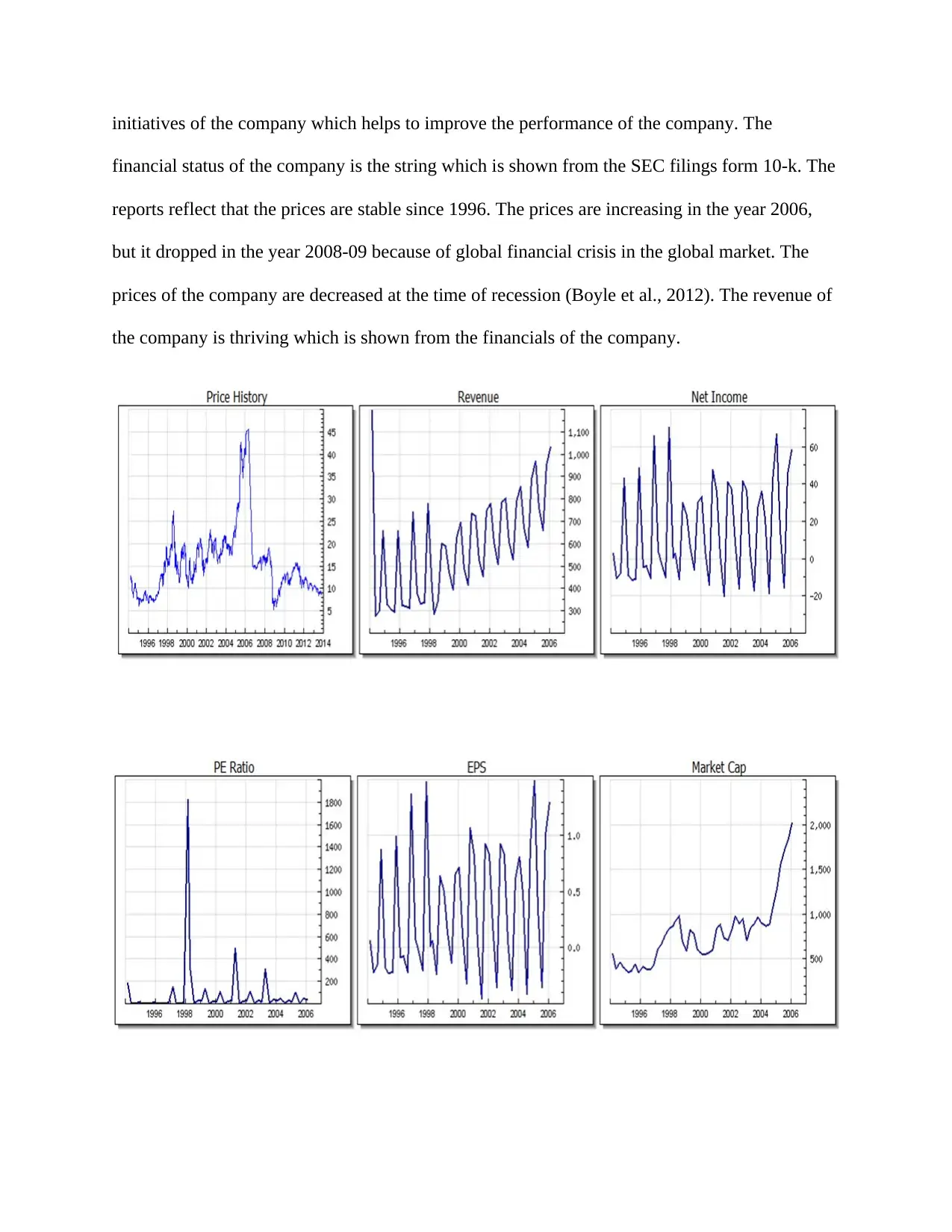
initiatives of the company which helps to improve the performance of the company. The
financial status of the company is the string which is shown from the SEC filings form 10-k. The
reports reflect that the prices are stable since 1996. The prices are increasing in the year 2006,
but it dropped in the year 2008-09 because of global financial crisis in the global market. The
prices of the company are decreased at the time of recession (Boyle et al., 2012). The revenue of
the company is thriving which is shown from the financials of the company.
financial status of the company is the string which is shown from the SEC filings form 10-k. The
reports reflect that the prices are stable since 1996. The prices are increasing in the year 2006,
but it dropped in the year 2008-09 because of global financial crisis in the global market. The
prices of the company are decreased at the time of recession (Boyle et al., 2012). The revenue of
the company is thriving which is shown from the financials of the company.
Paraphrase This Document
Need a fresh take? Get an instant paraphrase of this document with our AI Paraphraser


⊘ This is a preview!⊘
Do you want full access?
Subscribe today to unlock all pages.

Trusted by 1+ million students worldwide
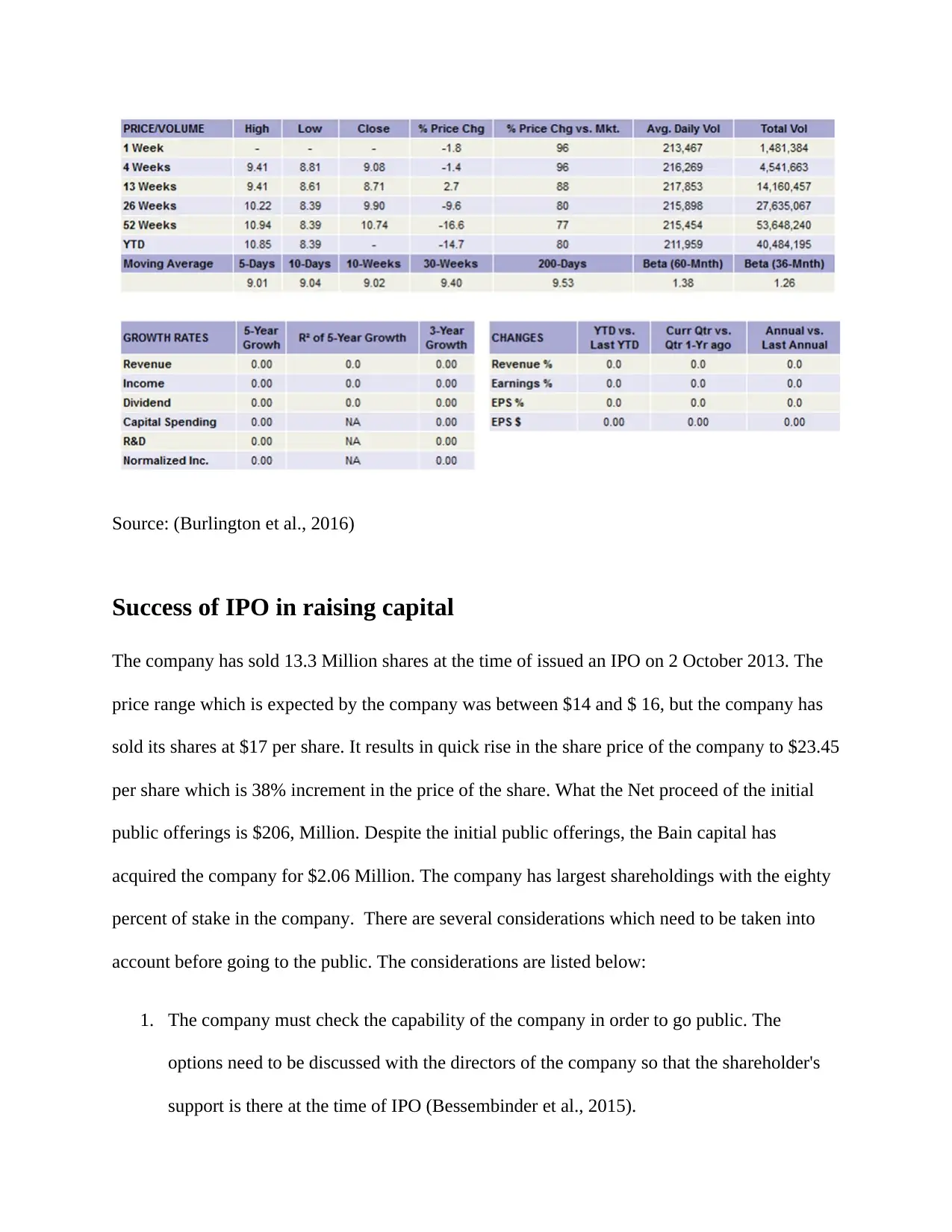
Source: (Burlington et al., 2016)
Success of IPO in raising capital
The company has sold 13.3 Million shares at the time of issued an IPO on 2 October 2013. The
price range which is expected by the company was between $14 and $ 16, but the company has
sold its shares at $17 per share. It results in quick rise in the share price of the company to $23.45
per share which is 38% increment in the price of the share. What the Net proceed of the initial
public offerings is $206, Million. Despite the initial public offerings, the Bain capital has
acquired the company for $2.06 Million. The company has largest shareholdings with the eighty
percent of stake in the company. There are several considerations which need to be taken into
account before going to the public. The considerations are listed below:
1. The company must check the capability of the company in order to go public. The
options need to be discussed with the directors of the company so that the shareholder's
support is there at the time of IPO (Bessembinder et al., 2015).
Success of IPO in raising capital
The company has sold 13.3 Million shares at the time of issued an IPO on 2 October 2013. The
price range which is expected by the company was between $14 and $ 16, but the company has
sold its shares at $17 per share. It results in quick rise in the share price of the company to $23.45
per share which is 38% increment in the price of the share. What the Net proceed of the initial
public offerings is $206, Million. Despite the initial public offerings, the Bain capital has
acquired the company for $2.06 Million. The company has largest shareholdings with the eighty
percent of stake in the company. There are several considerations which need to be taken into
account before going to the public. The considerations are listed below:
1. The company must check the capability of the company in order to go public. The
options need to be discussed with the directors of the company so that the shareholder's
support is there at the time of IPO (Bessembinder et al., 2015).
Paraphrase This Document
Need a fresh take? Get an instant paraphrase of this document with our AI Paraphraser
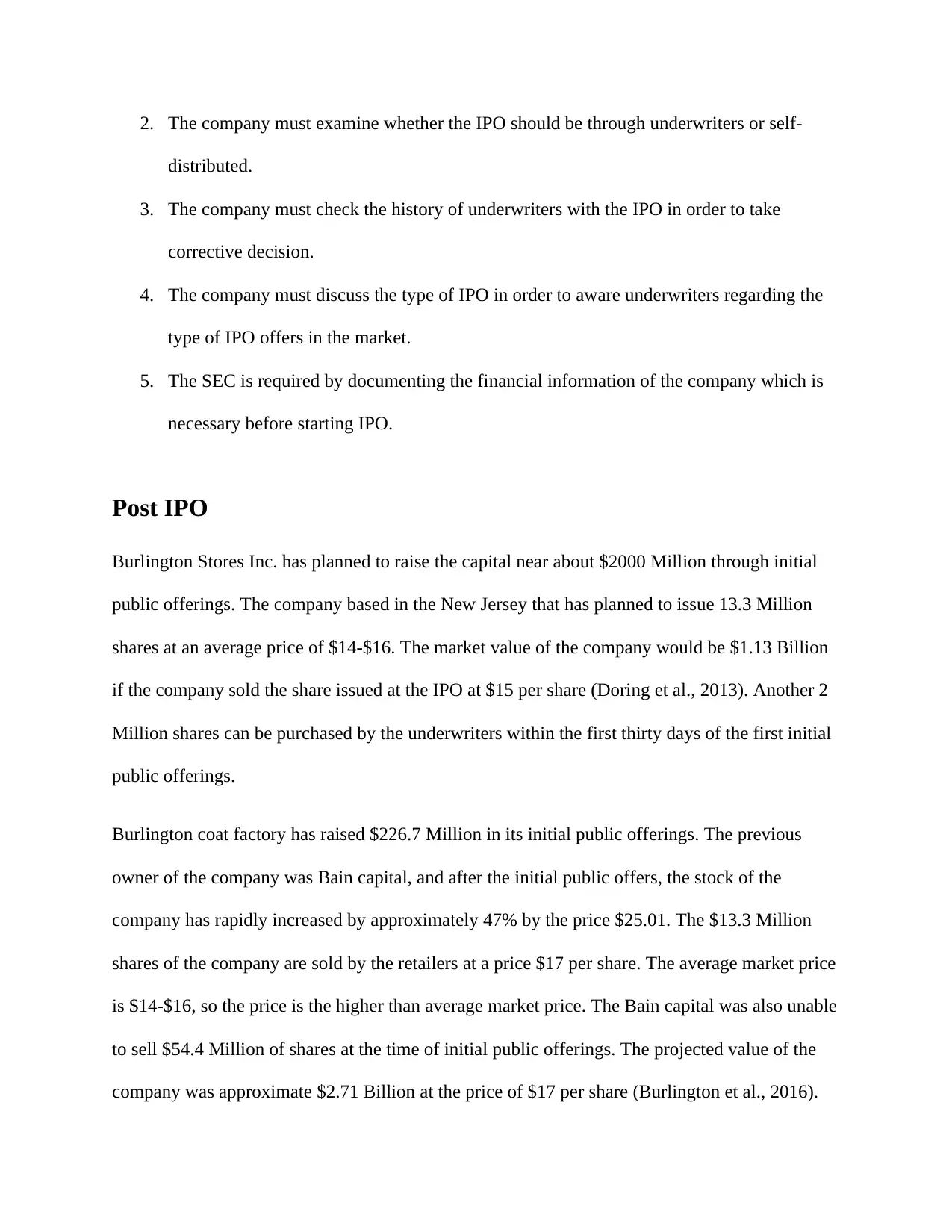
2. The company must examine whether the IPO should be through underwriters or self-
distributed.
3. The company must check the history of underwriters with the IPO in order to take
corrective decision.
4. The company must discuss the type of IPO in order to aware underwriters regarding the
type of IPO offers in the market.
5. The SEC is required by documenting the financial information of the company which is
necessary before starting IPO.
Post IPO
Burlington Stores Inc. has planned to raise the capital near about $2000 Million through initial
public offerings. The company based in the New Jersey that has planned to issue 13.3 Million
shares at an average price of $14-$16. The market value of the company would be $1.13 Billion
if the company sold the share issued at the IPO at $15 per share (Doring et al., 2013). Another 2
Million shares can be purchased by the underwriters within the first thirty days of the first initial
public offerings.
Burlington coat factory has raised $226.7 Million in its initial public offerings. The previous
owner of the company was Bain capital, and after the initial public offers, the stock of the
company has rapidly increased by approximately 47% by the price $25.01. The $13.3 Million
shares of the company are sold by the retailers at a price $17 per share. The average market price
is $14-$16, so the price is the higher than average market price. The Bain capital was also unable
to sell $54.4 Million of shares at the time of initial public offerings. The projected value of the
company was approximate $2.71 Billion at the price of $17 per share (Burlington et al., 2016).
distributed.
3. The company must check the history of underwriters with the IPO in order to take
corrective decision.
4. The company must discuss the type of IPO in order to aware underwriters regarding the
type of IPO offers in the market.
5. The SEC is required by documenting the financial information of the company which is
necessary before starting IPO.
Post IPO
Burlington Stores Inc. has planned to raise the capital near about $2000 Million through initial
public offerings. The company based in the New Jersey that has planned to issue 13.3 Million
shares at an average price of $14-$16. The market value of the company would be $1.13 Billion
if the company sold the share issued at the IPO at $15 per share (Doring et al., 2013). Another 2
Million shares can be purchased by the underwriters within the first thirty days of the first initial
public offerings.
Burlington coat factory has raised $226.7 Million in its initial public offerings. The previous
owner of the company was Bain capital, and after the initial public offers, the stock of the
company has rapidly increased by approximately 47% by the price $25.01. The $13.3 Million
shares of the company are sold by the retailers at a price $17 per share. The average market price
is $14-$16, so the price is the higher than average market price. The Bain capital was also unable
to sell $54.4 Million of shares at the time of initial public offerings. The projected value of the
company was approximate $2.71 Billion at the price of $17 per share (Burlington et al., 2016).
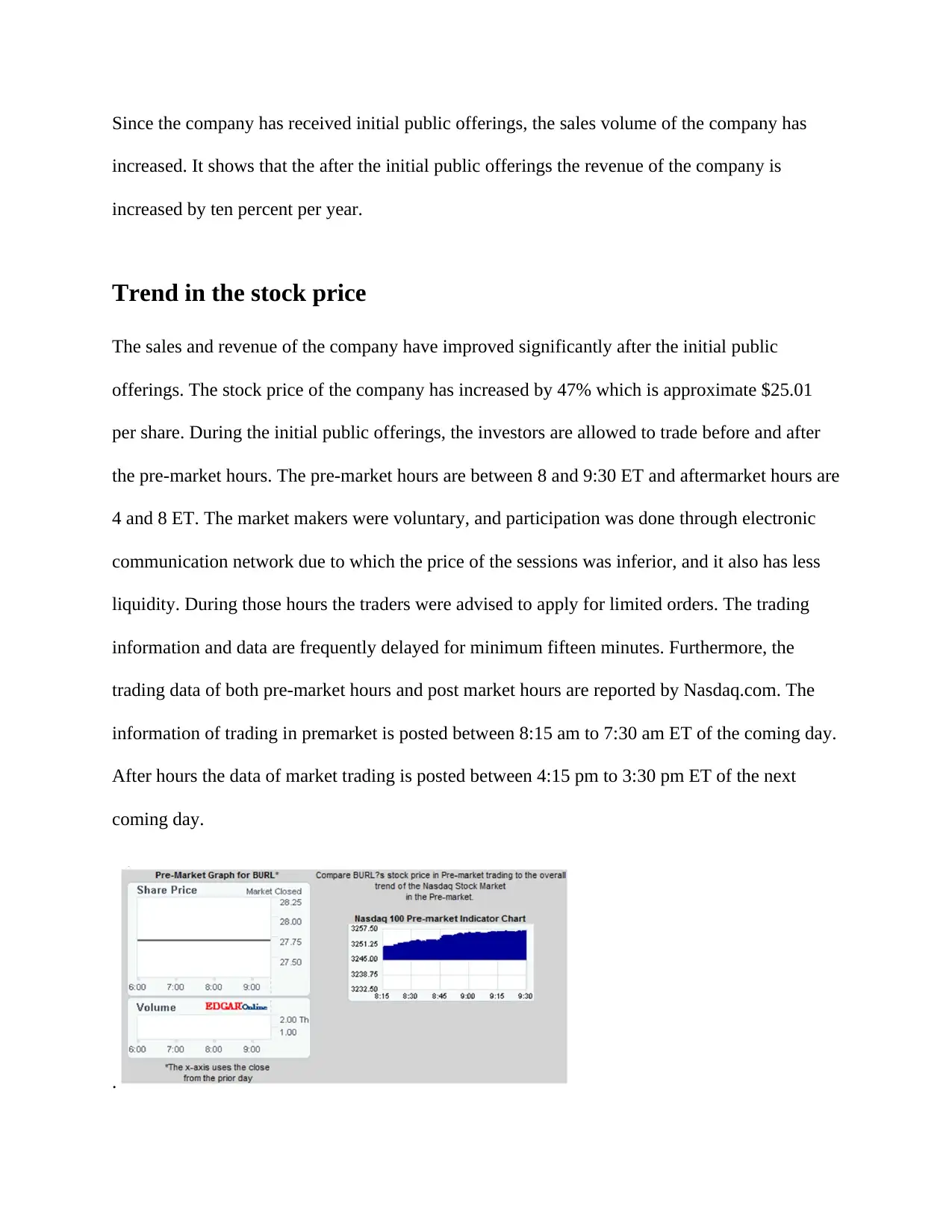
Since the company has received initial public offerings, the sales volume of the company has
increased. It shows that the after the initial public offerings the revenue of the company is
increased by ten percent per year.
Trend in the stock price
The sales and revenue of the company have improved significantly after the initial public
offerings. The stock price of the company has increased by 47% which is approximate $25.01
per share. During the initial public offerings, the investors are allowed to trade before and after
the pre-market hours. The pre-market hours are between 8 and 9:30 ET and aftermarket hours are
4 and 8 ET. The market makers were voluntary, and participation was done through electronic
communication network due to which the price of the sessions was inferior, and it also has less
liquidity. During those hours the traders were advised to apply for limited orders. The trading
information and data are frequently delayed for minimum fifteen minutes. Furthermore, the
trading data of both pre-market hours and post market hours are reported by Nasdaq.com. The
information of trading in premarket is posted between 8:15 am to 7:30 am ET of the coming day.
After hours the data of market trading is posted between 4:15 pm to 3:30 pm ET of the next
coming day.
.
increased. It shows that the after the initial public offerings the revenue of the company is
increased by ten percent per year.
Trend in the stock price
The sales and revenue of the company have improved significantly after the initial public
offerings. The stock price of the company has increased by 47% which is approximate $25.01
per share. During the initial public offerings, the investors are allowed to trade before and after
the pre-market hours. The pre-market hours are between 8 and 9:30 ET and aftermarket hours are
4 and 8 ET. The market makers were voluntary, and participation was done through electronic
communication network due to which the price of the sessions was inferior, and it also has less
liquidity. During those hours the traders were advised to apply for limited orders. The trading
information and data are frequently delayed for minimum fifteen minutes. Furthermore, the
trading data of both pre-market hours and post market hours are reported by Nasdaq.com. The
information of trading in premarket is posted between 8:15 am to 7:30 am ET of the coming day.
After hours the data of market trading is posted between 4:15 pm to 3:30 pm ET of the next
coming day.
.
⊘ This is a preview!⊘
Do you want full access?
Subscribe today to unlock all pages.

Trusted by 1+ million students worldwide

Conclusions
From the above analysis, it can be concluded that the initial public offering had the positive
impact on the financial growth of the company. The revenue of the company increases after
initial public offerings. According to the 10k form of Sec filings the revenue of the company
increased which helps to expand the business. The company was established in 1972, and it is the
leader in the off-price retail industry. The financial facts show that the company is financially
stable and non-financial facts show that the brand image of the company in the eyes of the
customers is also good. The company has sold its $13.3 Million shares at the time of initial
public offerings in the year 2013, and the company has sold its shares in more than the
expectations of the company. After initial public offerings, the revenue of the company has
improved which increase the shareholder's profits within the particular time period. The trend of
shares has also improved after the initial public offerings. The stock price is increased by 47%
after the initial public offerings.
From the above analysis, it can be concluded that the initial public offering had the positive
impact on the financial growth of the company. The revenue of the company increases after
initial public offerings. According to the 10k form of Sec filings the revenue of the company
increased which helps to expand the business. The company was established in 1972, and it is the
leader in the off-price retail industry. The financial facts show that the company is financially
stable and non-financial facts show that the brand image of the company in the eyes of the
customers is also good. The company has sold its $13.3 Million shares at the time of initial
public offerings in the year 2013, and the company has sold its shares in more than the
expectations of the company. After initial public offerings, the revenue of the company has
improved which increase the shareholder's profits within the particular time period. The trend of
shares has also improved after the initial public offerings. The stock price is increased by 47%
after the initial public offerings.
Paraphrase This Document
Need a fresh take? Get an instant paraphrase of this document with our AI Paraphraser
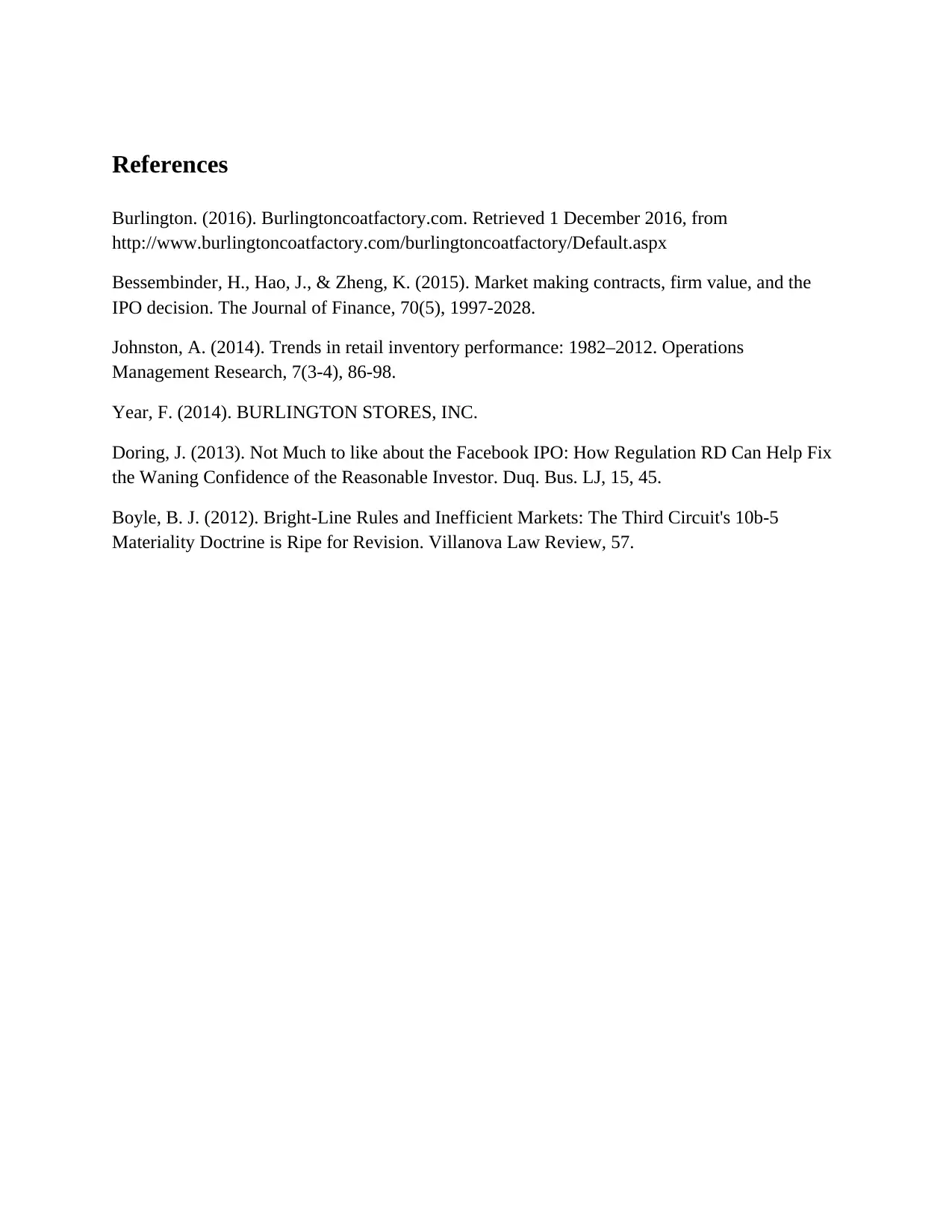
References
Burlington. (2016). Burlingtoncoatfactory.com. Retrieved 1 December 2016, from
http://www.burlingtoncoatfactory.com/burlingtoncoatfactory/Default.aspx
Bessembinder, H., Hao, J., & Zheng, K. (2015). Market making contracts, firm value, and the
IPO decision. The Journal of Finance, 70(5), 1997-2028.
Johnston, A. (2014). Trends in retail inventory performance: 1982–2012. Operations
Management Research, 7(3-4), 86-98.
Year, F. (2014). BURLINGTON STORES, INC.
Doring, J. (2013). Not Much to like about the Facebook IPO: How Regulation RD Can Help Fix
the Waning Confidence of the Reasonable Investor. Duq. Bus. LJ, 15, 45.
Boyle, B. J. (2012). Bright-Line Rules and Inefficient Markets: The Third Circuit's 10b-5
Materiality Doctrine is Ripe for Revision. Villanova Law Review, 57.
Burlington. (2016). Burlingtoncoatfactory.com. Retrieved 1 December 2016, from
http://www.burlingtoncoatfactory.com/burlingtoncoatfactory/Default.aspx
Bessembinder, H., Hao, J., & Zheng, K. (2015). Market making contracts, firm value, and the
IPO decision. The Journal of Finance, 70(5), 1997-2028.
Johnston, A. (2014). Trends in retail inventory performance: 1982–2012. Operations
Management Research, 7(3-4), 86-98.
Year, F. (2014). BURLINGTON STORES, INC.
Doring, J. (2013). Not Much to like about the Facebook IPO: How Regulation RD Can Help Fix
the Waning Confidence of the Reasonable Investor. Duq. Bus. LJ, 15, 45.
Boyle, B. J. (2012). Bright-Line Rules and Inefficient Markets: The Third Circuit's 10b-5
Materiality Doctrine is Ripe for Revision. Villanova Law Review, 57.

Ref
⊘ This is a preview!⊘
Do you want full access?
Subscribe today to unlock all pages.

Trusted by 1+ million students worldwide
1 out of 12
Related Documents
Your All-in-One AI-Powered Toolkit for Academic Success.
+13062052269
info@desklib.com
Available 24*7 on WhatsApp / Email
![[object Object]](/_next/static/media/star-bottom.7253800d.svg)
Unlock your academic potential
Copyright © 2020–2025 A2Z Services. All Rights Reserved. Developed and managed by ZUCOL.





